Understanding the Impacts of Rainfall Variability on Natural Forage–Livestock Dynamics in Arid and Semi-Arid Environments
Abstract
1. Introduction
2. Materials and Methods
2.1. Study Area
2.2. Model Formulation and Description
- Livestock depend on the availability of food to reproduce. Their nutrients are mostly found on natural forage if they are not given supplementary feeds [31].
- There is a relationship between seasonal variation of rainfall and plant growth. There is a significant season-to-season variability in rainfall amount and distribution [32]. Within the semi-arid forests, there may be little seasonal rhythm in the growth and development of vegetation as a whole. Summer, spring, and autumn are seasons experiencing rainfall; particularly, the summer season is known for extreme rainfall and is well distributed in most parts of the country [12]. A season varies from three to four months. More vegetative growth starts around spring, and flourishing occurs mid-spring up to autumn. In winter, there is no vegetation growth because of no rainfall and extreme cold temperature variation.
- A constant per-capita death rate of livestock (d):, It is assumed in this study that the mean death rate of livestock is constant as used in [33]. However, some authors [9,16] consider a non-constant or plant-dependent death rate with the assumption that livestock die off exponentially in the absence of plants. If livestock eat more, they will be less likely to die from starvation or from the consequences of weakness brought by hunger.
- Harvest rate, : This is considered a constant, and it represents the human interference in the system by removing livestock from the system at a constant rate. It is the removal of animals through consumption and/or selling.
- Plant growth rate function, : The amount and distribution of rainfall have a strong impact on the development of plants. A certain minimal amount of moisture is needed to activate seed germination and reproduction. That is, they become abundantly green and grow during the rainy season, and they die out or do not grow during droughts. The rate or amount in which rain is received at a time could be too much or too low for the environment. Too much water injures plants, compacts soils, and leads to soil erosion [34]. Root loss occurs when excess water reduces oxygen in the soil. Extreme summer rain can leach nitrogen out of the soil. Excessive rainfall is not necessarily useful or desirable at all times. Some of it is unavoidably wasted, while some may cause destruction [34]. If the average rainfall is much lower than the ‘ideal’ amount needed, it could lead to the dying of plants and grasses [35]. Most grasses in Botswana are seasonal; that is, they grow in summer during the rainy season and become dry and die out during the winter season when rainfall reduces or is not at all.Therefore, in this paper, we consider rainfall to be a factor that affects plant growth rate. The plant growth in this study refers to the increase in plant biomass that is edible by the livestock, and we represent this information by the model below for :where A is a given constant, and is the value that takes the effects of soil type and soil texture on the growth rate. represents daily rainfall data, is the mean of rainfall data, represents the standard deviation from while . We also assume that is -periodic, with days (or 1 year).
- Sinusoidal response term: The term represents the rate of plant growth at the beginning of the spring season. Plants are structurally smart and can sense their environments changing, and those changes signal them to start to grow again. For example, when plants experience a number of warm days, they are prompted to start growing again. Buds begin to appear on trees. Glucose that was produced during photosynthesis and stored in the roots will provide plants with energy and food for budding. The delay of rain will make plants finish stored glucose and begin to die [36].
- Soil structure, : This term represents the physical characteristics of soil in reducing the growth of plants. According to Passioura [37], roots grow most rapidly in very friable soil, but their uptake of water and nutrients may be limited by inadequate contact with the solid and liquid phases of the soil.
2.3. Mathematical Analysis
2.3.1. Well-Posedness of Model
2.3.2. Boundedness
2.3.3. Coexistence Solution and Livestock-Free Solution
3. Numerical Simulations and Discussion
3.1. Parameter Values
3.1.1. Effects of Change in Rainfall Intensity in Botswana
3.1.2. Effects of Rainfall Timing in Different Regions of Botswana
3.1.3. Effect of Harvest Rate ()
4. Conclusions
Author Contributions
Funding
Institutional Review Board Statement
Informed Consent Statement
Data Availability Statement
Conflicts of Interest
References
- Schiess-Meier, M.; Ramsauer, S.; Gabanapelo, T.; König, B. Livestock predation—Insights from problem animal control registers in Botswana. J. Wildl. Manag. 2007, 71, 1267–1274. [Google Scholar] [CrossRef]
- Schlink, A.; Nguyen, M.; Viljoen, G. Water requirements for livestock production: A global perspective. Rev. Sci. Tech. 2010, 29, 603–619. [Google Scholar] [PubMed]
- Seré, C.; Steinfeld, H.; Groenewold, J. World Livestock Production Systems; Food and Agriculture Organization of the United Nations: Rome, Italy, 1996. [Google Scholar]
- Miranda-de la Lama, G.C.; Mattiello, S. The importance of social behaviour for goat welfare in livestock farming. Small Rumin. Res. 2010, 90, 1–10. [Google Scholar]
- Neethirajan, S.; Kemp, B. Digital livestock farming. Sens. Bio Sens. Res. 2021, 32, 100408. [Google Scholar]
- Steinfeld, H. Livestock’s Long Shadow: Environmental Issues and Options; Food & Agriculture Organization: Rome, Italy, 2006. [Google Scholar]
- FAO, Unesco. Global Agriculture Towards 2050. High Level Expert Forum Issues Paper; Food and Agriculture Organization of the United Nations: Rome, Italy, 2009. [Google Scholar]
- Darkoh, M.B.; Mbaiwa, J.E. Globalisation and the livestock industry in Botswana. Singap. J. Trop. Geogr. 2002, 23, 149–166. [Google Scholar]
- Asfaw, M.D.; Kassa, S.M.; Lungu, E.M. Co-existence thresholds in the dynamics of the plant–herbivore interaction with Allee effect and harvest. Int. J. Biomath. 2018, 11, 1850057. [Google Scholar]
- Kgosikoma, O.E. Effects of Climate Variability on Livestock Population Dynamics and Community Drought Management in Kgalagadi, Botswana. Ph.D. Thesis, Norwegian University of Life Sciences, Ås, Norway, 2006. [Google Scholar]
- Moreki, J.; Tsopito, C. Effect of climate change on dairy production in Botswana and its suitable mitigation strategies. Online J. Anim. Feed. Res. 2013, 3, 216–221. [Google Scholar]
- Batisani, N.; Yarnal, B. Rainfall variability and trends in semi-arid Botswana: Implications for climate change adaptation policy. Appl. Geogr. 2010, 30, 483–489. [Google Scholar]
- Ejigu, A.A.; Asfaw, M.D.; Kassa, S.M. Estimating the spatial distribution of possible livestock production level using a mathematical model and the SMAP soil moisture data: The case of Botswana. Commun. Math. Biol. Neurosci. 2022, 2022, 124. [Google Scholar]
- Troiano, C.; Buglione, M.; Petrelli, S.; Belardinelli, S.; De Natale, A.; Svenning, J.C.; Fulgione, D. Traditional free-ranging livestock farming as a management strategy for biological and cultural landscape diversity: A case from the southern apennines. Land 2021, 10, 957. [Google Scholar] [CrossRef]
- Behnke, R.H., Jr. Cattle accumulation and the commercialization of the traditional livestock industry in Botswana. Agric. Syst. 1987, 24, 1–29. [Google Scholar]
- Asfaw, M.D.; Kassa, S.M.; Lungu, E.M.; Bewket, W. Effects of temperature and rainfall in plant–herbivore interactions at different altitude. Ecol. Model. 2019, 406, 50–59. [Google Scholar]
- Kassa, S.M.; Asfaw, M.D.; Ejigu, A.A.; Tsidu, G.M. Modeling natural forage dependent livestock production in arid and semi-arid regions: Analysis of seasonal soil moisture variability and environmental factors. Model. Earth Syst. Environ. 2024, 10, 3645–3663. [Google Scholar]
- Godde, C.M.; Boone, R.B.; Ash, A.J.; Waha, K.; Sloat, L.L.; Thornton, P.K.; Herrero, M. Global rangeland production systems and livelihoods at threat under climate change and variability. Environ. Res. Lett. 2020, 15, 044021. [Google Scholar]
- Kebede, D. Impact of climate change on livestock productive and reproductive performance. Livest. Res. Rural. Dev. 2016, 28, 227. [Google Scholar]
- Sloat, L.L.; Gerber, J.S.; Samberg, L.H.; Smith, W.K.; Herrero, M.; Ferreira, L.G.; Godde, C.M.; West, P.C. Increasing importance of precipitation variability on global livestock grazing lands. Nat. Clim. Change 2018, 8, 214–218. [Google Scholar]
- Giridhar, K.; Samireddypalle, A. Impact of climate change on forage availability for livestock. In Climate Change Impact on Livestock: Adaptation and Mitigation; Springer: New Delhi, India, 2015; pp. 97–112. [Google Scholar]
- Cain, J.W.; Gedir, J.V.; Marshal, J.P.; Krausman, P.R.; Allen, J.D.; Duff, G.C.; Jansen, B.D.; Morgart, J.R. Extreme precipitation variability, forage quality and large herbivore diet selection in arid environments. Oikos 2017, 126, 1459–1471. [Google Scholar]
- Baumgard, L.H.; Rhoads, R.P.; Rhoads, M.L.; Gabler, N.K.; Ross, J.W.; Keating, A.F.; Boddicker, R.L.; Lenka, S.; Sejian, V. Impact of climate change on livestock production. Environ. Stress Amelior. Livest. Prod. 2012, 15, 413–468. [Google Scholar]
- Bekele, S. Impacts of climate change on livestock production: A review. J. Nat. Sci. Res. 2017, 7, 53–59. [Google Scholar]
- Wikipedia Contributors. Statistics Botswana—Wikipedia, The Free Encyclopedia. 2023. Available online: https://en.wikipedia.org/w/index.php?title=Statistics_Botswana&oldid=1151523833 (accessed on 12 June 2023).
- Wikipedia Contributors. Geography of Botswana—Wikipedia, The Free Encyclopedia. 2022. Available online: https://en.wikipedia.org/w/index.php?title=Geography_of_Botswana&oldid=1126000541 (accessed on 12 June 2023).
- Centre for Applied Research. Botswana Country Report ICRISAT-ILRI Project Priorities for Future Research on Crop-Livestock Systems; Final Report December 2005; Government of Botswana: Gaborone, Botswana, 2005.
- Vossen, P. Rainfall and agricultural production in Botswana. Afr. Focus 1990, 6, 141–155. [Google Scholar]
- Barnes, J.I.; Cannon, J.; Macgregor, J. Livestock production economics on communal land in Botswana: Effects of tenure, scale and subsidies. Dev. S. Afr. 2008, 25, 327–345. [Google Scholar]
- Asfaw, M.D.; Kassa, S.M.; Lungu, E.M. Stochastic plant-herbivore interaction model with Allee effect. J. Math. Biol. 2019, 79, 2183–2209. [Google Scholar]
- Bindari, Y.R.; Shrestha, S.; Shrestha, N.; Gaire, T.N. Effects of nutrition on reproduction—A review. Adv. Appl. Sci. Res 2013, 4, 421–429. [Google Scholar]
- Kumar Guntu, R.; Agarwal, A. Investigation of Precipitation Variability and Extremes Using Information Theory. Environ. Sci. Proc. 2020, 4, 14. [Google Scholar] [CrossRef]
- Abrams, P.A.; Ginzburg, L.R. The nature of predation: Prey dependent, ratio dependent or neither? Trends Ecol. Evol. 2000, 15, 337–341. [Google Scholar]
- Sakio, H. Effects of flooding on growth of seedlings of woody riparian species. J. For. Res. 2005, 10, 341–346. [Google Scholar]
- Kneebone, W.; Kopec, D.; Mancino, C. Water requirements and irrigation. Turfgrass 1992, 32, 441–472. [Google Scholar]
- Cho, L.H.; Pasriga, R.; Yoon, J.; Jeon, J.S.; An, G. Roles of sugars in controlling flowering time. J. Plant Biol. 2018, 61, 121–130. [Google Scholar]
- Passioura, J. Soil structure and plant growth. Soil Res. 1991, 29, 717–728. [Google Scholar] [CrossRef]
- Teschl, G. Ordinary Differential Equations and Dynamical Systems; American Mathematical Soc.: Providence, RI, USA, 2012; Volume 140. [Google Scholar]
- Smith, H.L. Monotone Dynamical Systems: An Introduction to the Theory of Competitive and Cooperative Systems: An Introduction to the Theory of Competitive and Cooperative Systems; American Mathematical Soc.: Providence, RI, USA, 1995. [Google Scholar]
- Mberego, S. Temporal patterns of precipitation and vegetation variability over Botswana during extreme dry and wet rainfall seasons. Int. J. Climatol. 2017, 37, 2947–2960. [Google Scholar]
- Puoetsile, A.; Lekgari, M.; Kassa, S.; Tsidu, G.M. Optimized Parameter Estimation and Integrating Neural Network Forecasting of Dynamic Plant-Livestock Model For Early Warning in Agro-Environment Control Systems. Stat. Optim. Inf. Comput. 2024, 12, 1460–1475. [Google Scholar] [CrossRef]
- Botswana, S. Annual Agricultural Survey Report 2019; Traditional Sector; Statistics Botswana: Gaborone, Botswana, 2020. [Google Scholar]
- Terry, A.J. Predator–prey models with component Allee effect for predator reproduction. J. Math. Biol. 2015, 71, 1325–1352. [Google Scholar] [CrossRef] [PubMed]
- Cline, M.G. Basic principles of soil classification. Soil Sci. 1949, 67, 81–92. [Google Scholar] [CrossRef]
- Hempel, J.; Michéli, E.; Owens, P.; McBratney, A. Universal soil classification system report from the International Union of Soil Sciences Working Group. Soil Horizons 2013, 54, 1–6. [Google Scholar] [CrossRef]
- Mphale, K.; Dash, S.; Adedoyin, A.; Panda, S. Rainfall regime changes and trends in Botswana Kalahari Transect’s late summer precipitation. Theor. Appl. Climatol. 2014, 116, 75–91. [Google Scholar] [CrossRef]
- Veenendaal, E.; Ernst, W.; Modise, G. Effect of seasonal rainfall pattern on seedling emergence and establishment of grasses in a savanna in south-eastern Botswana. J. Arid Environ. 1996, 32, 305–317. [Google Scholar] [CrossRef]
- Kenabatho, P.; Montshiwa, M. Integrated water resources management as a tool for drought planning and management in Botswana: A diagnostic approach. Int. J. Sustain. Dev. Plan. 2006, 1, 61–75. [Google Scholar] [CrossRef]
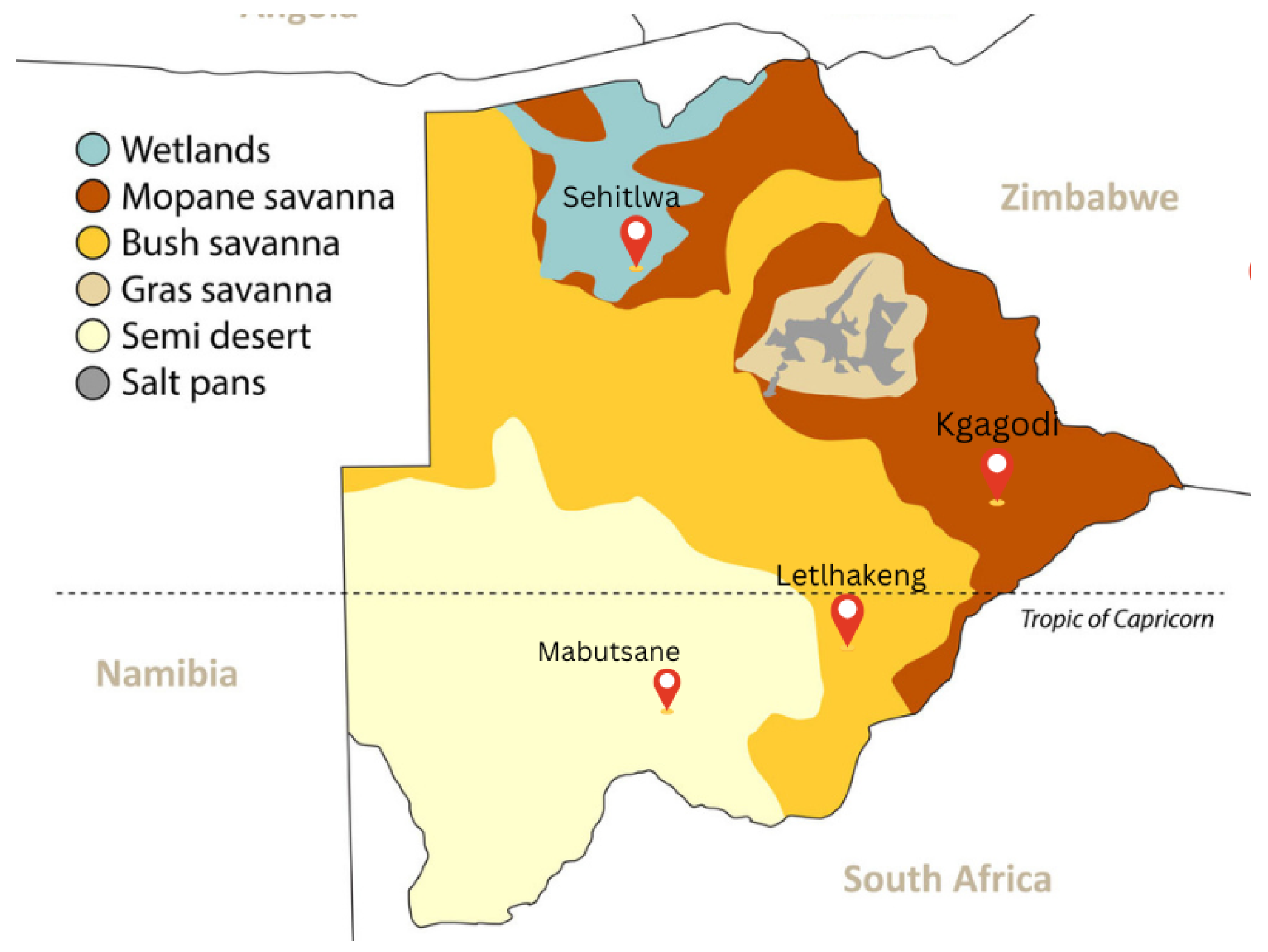
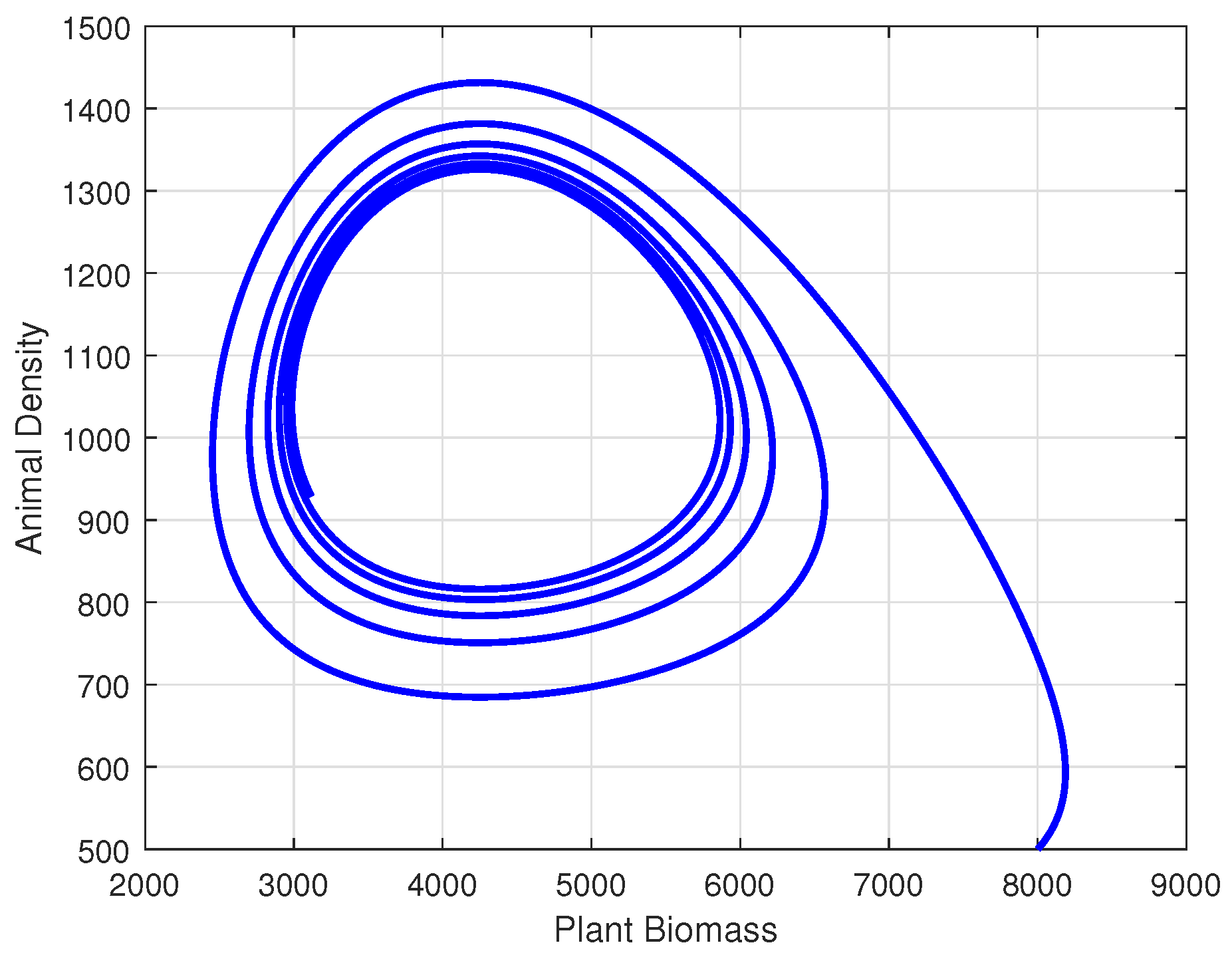
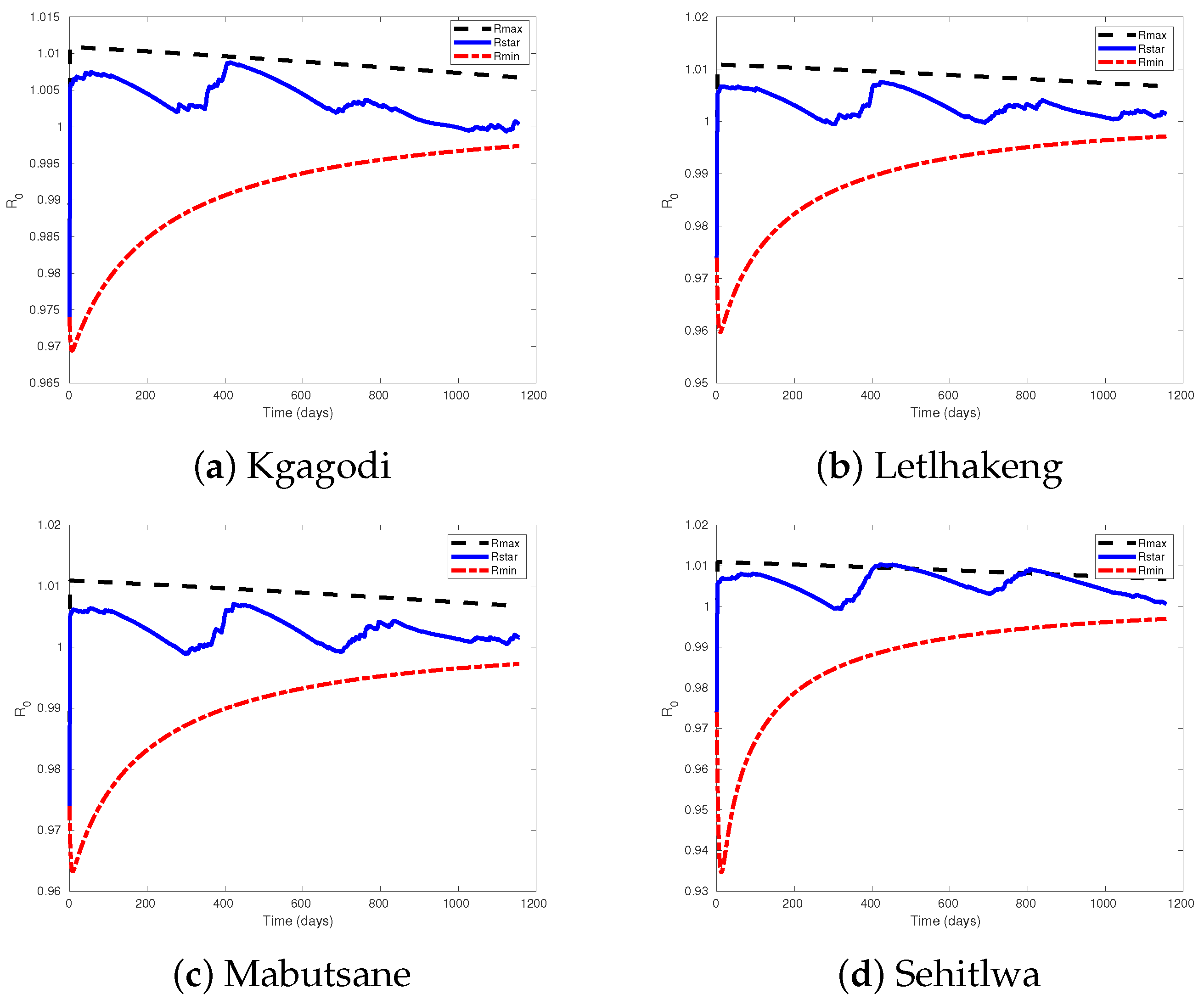
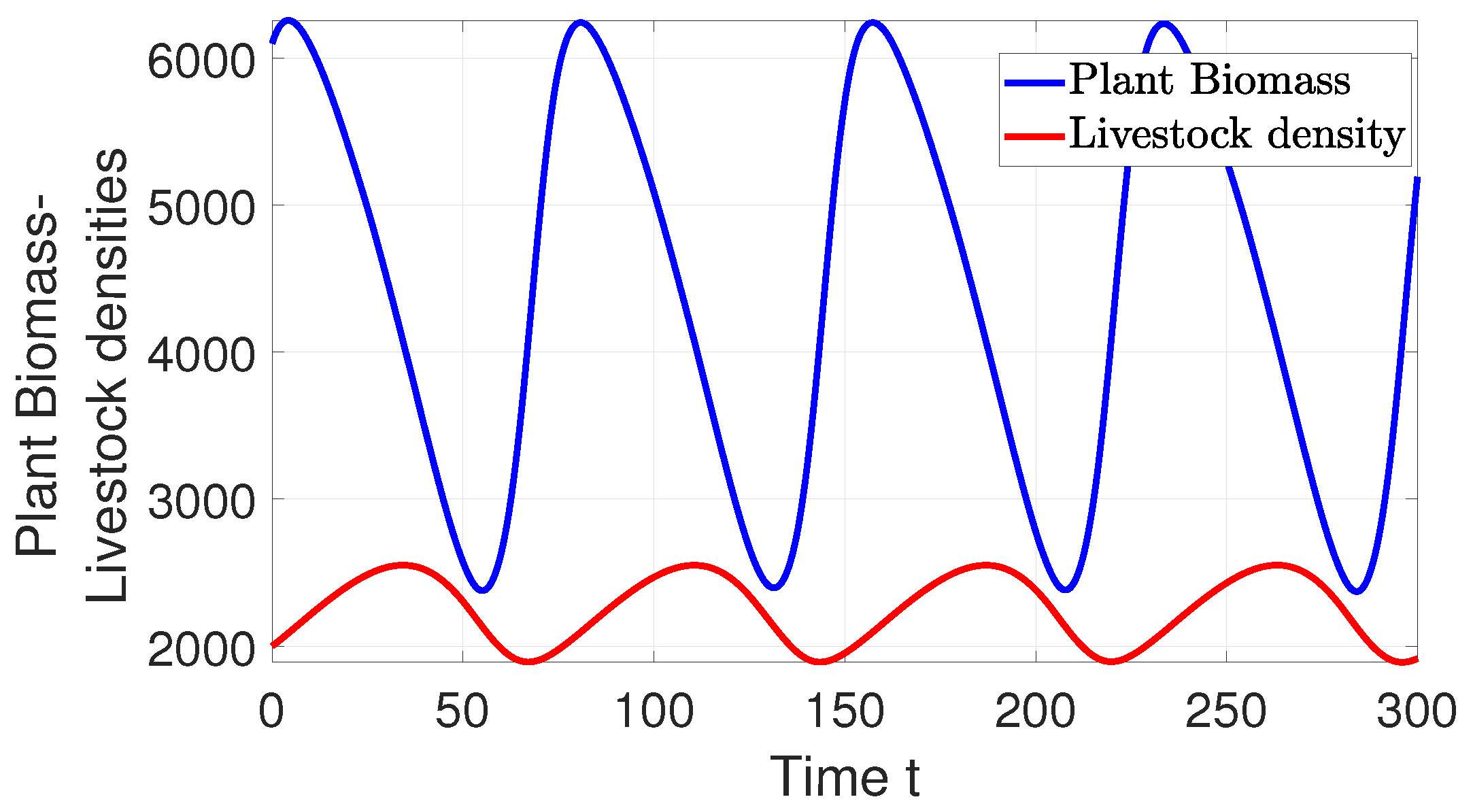
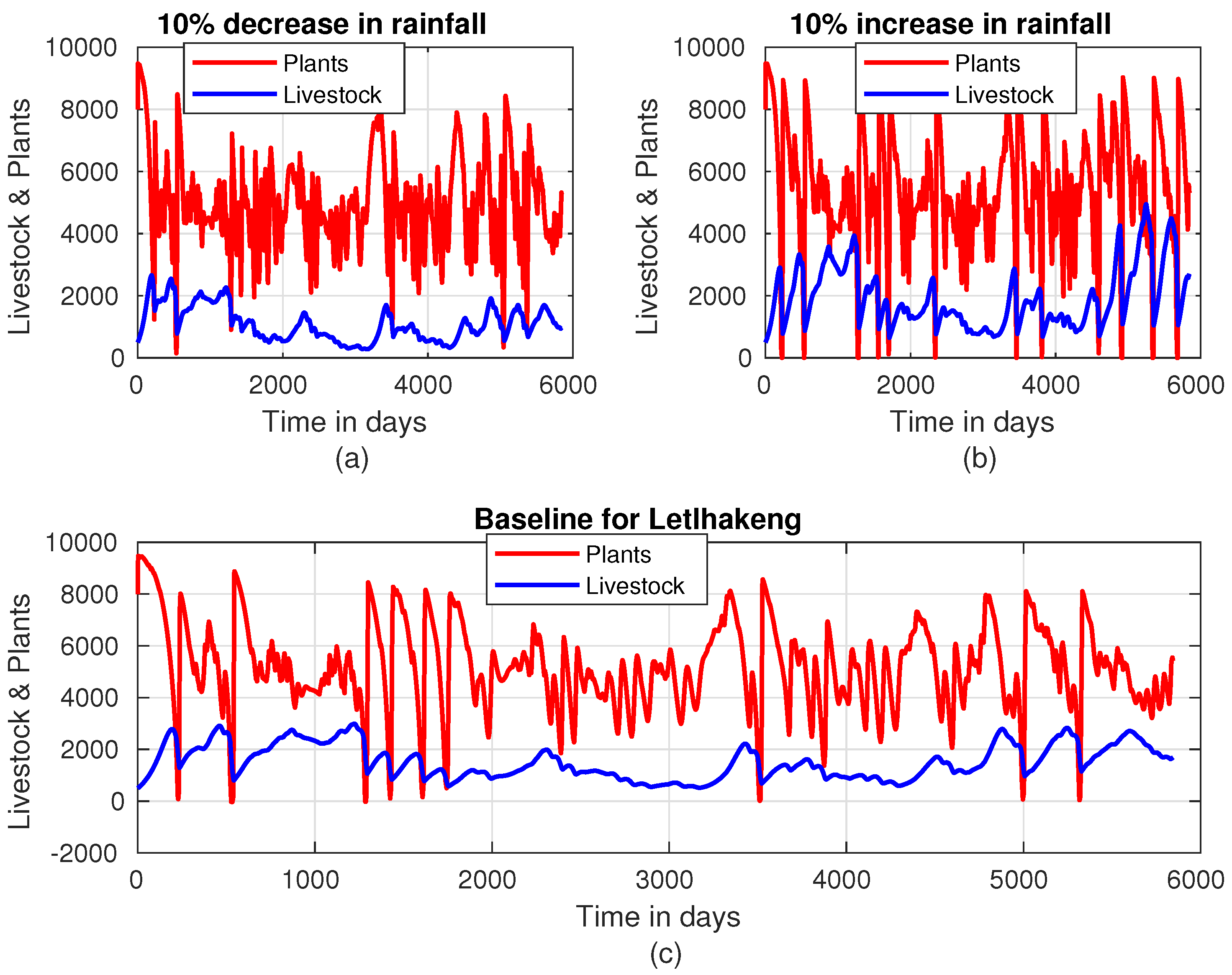
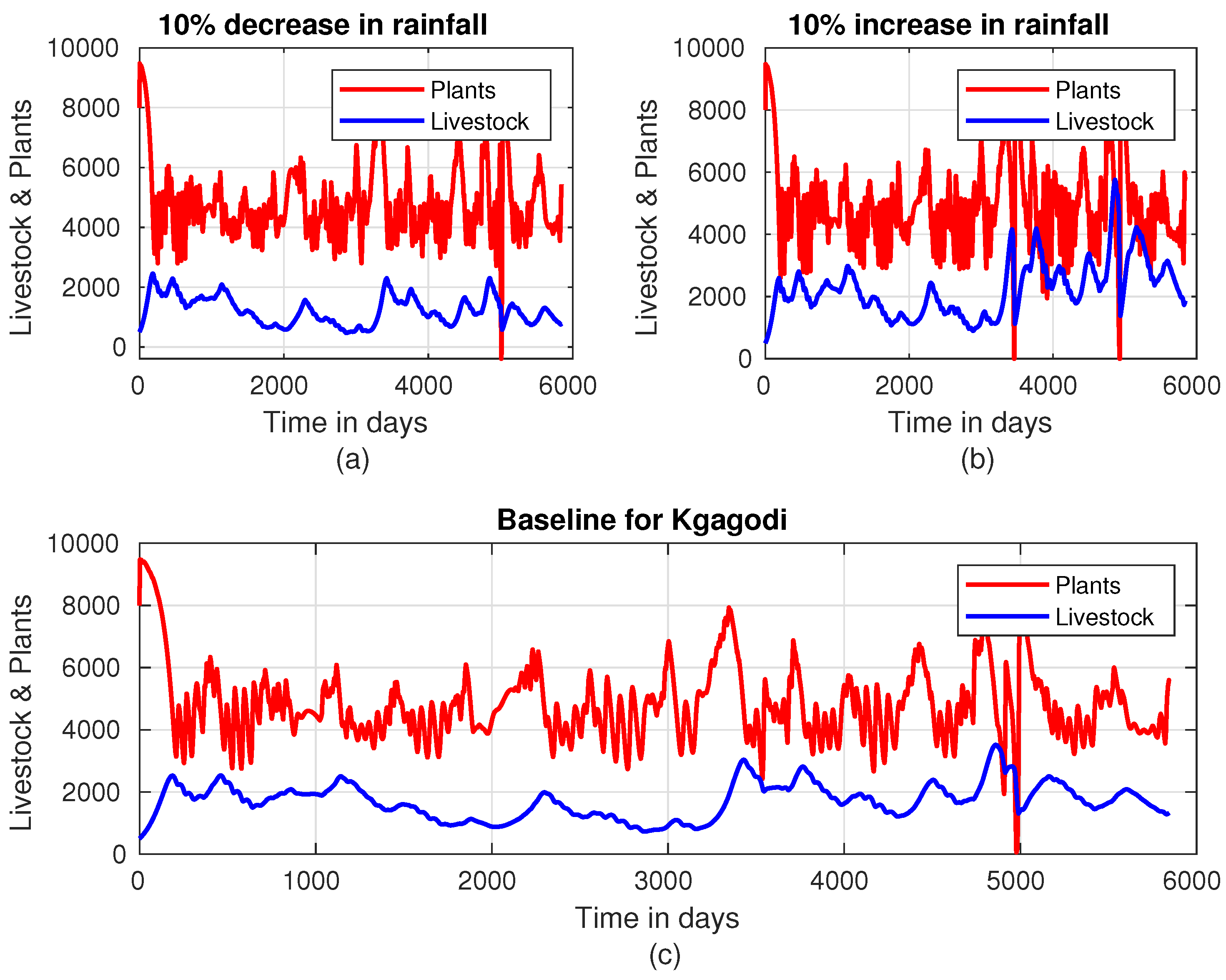
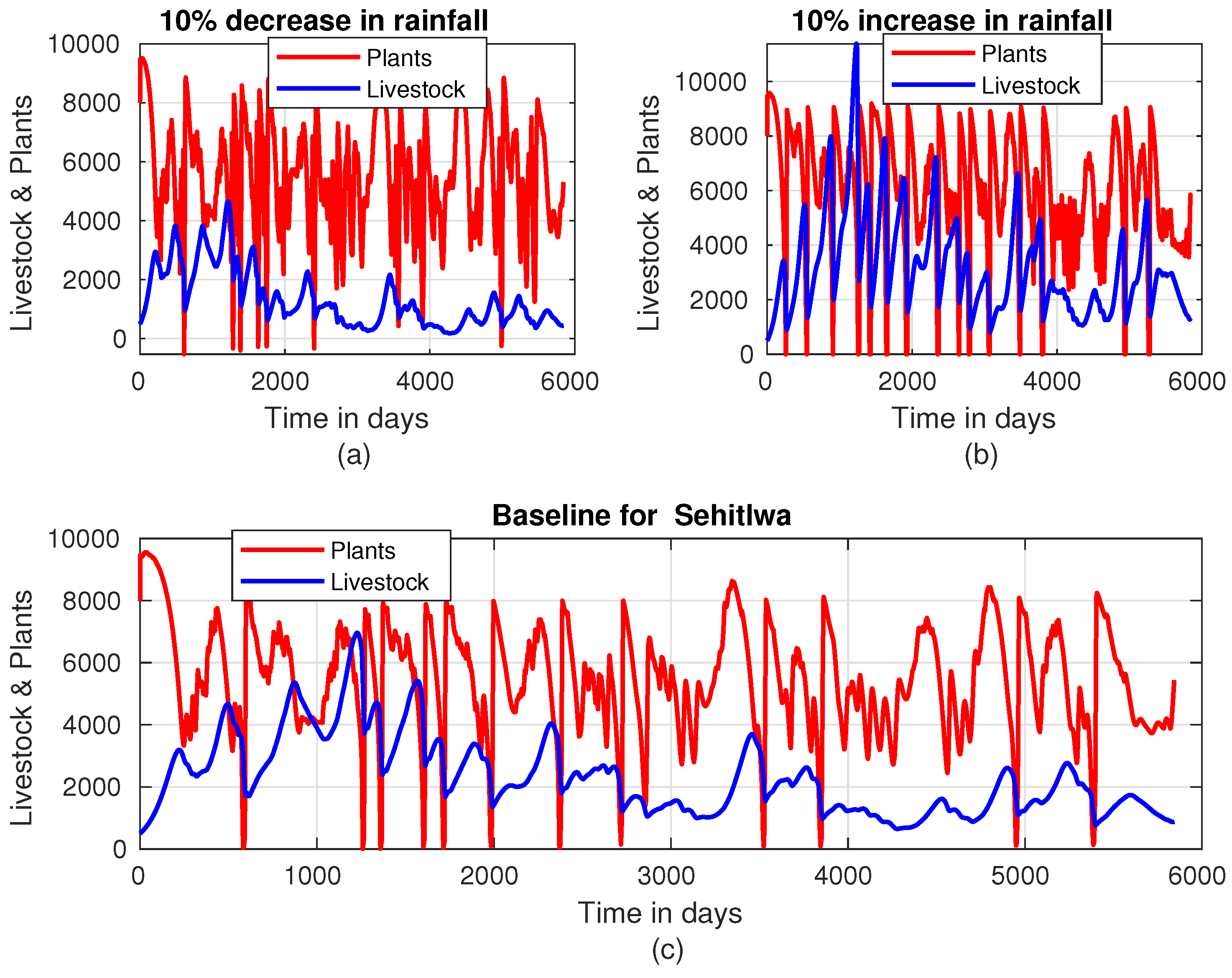
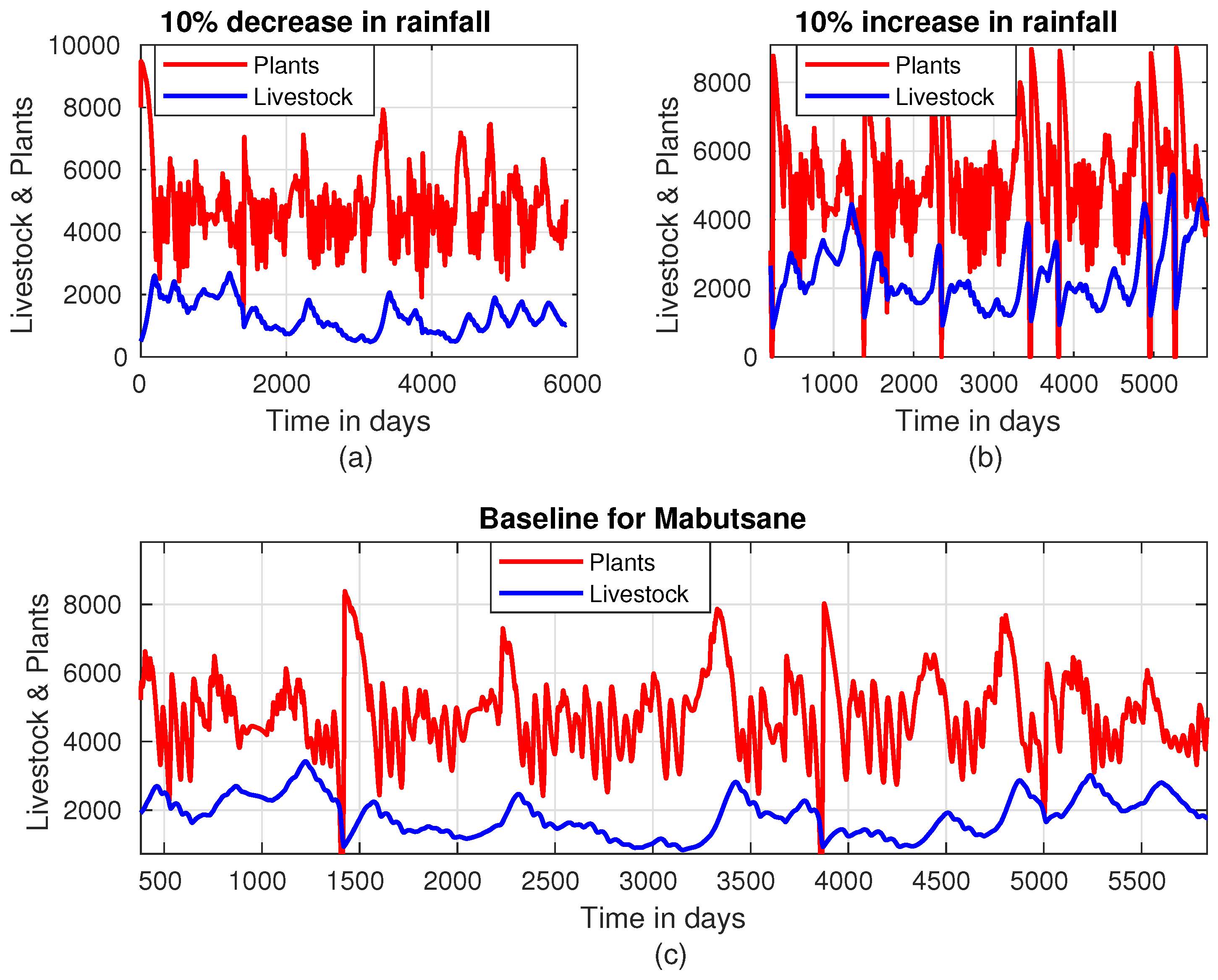
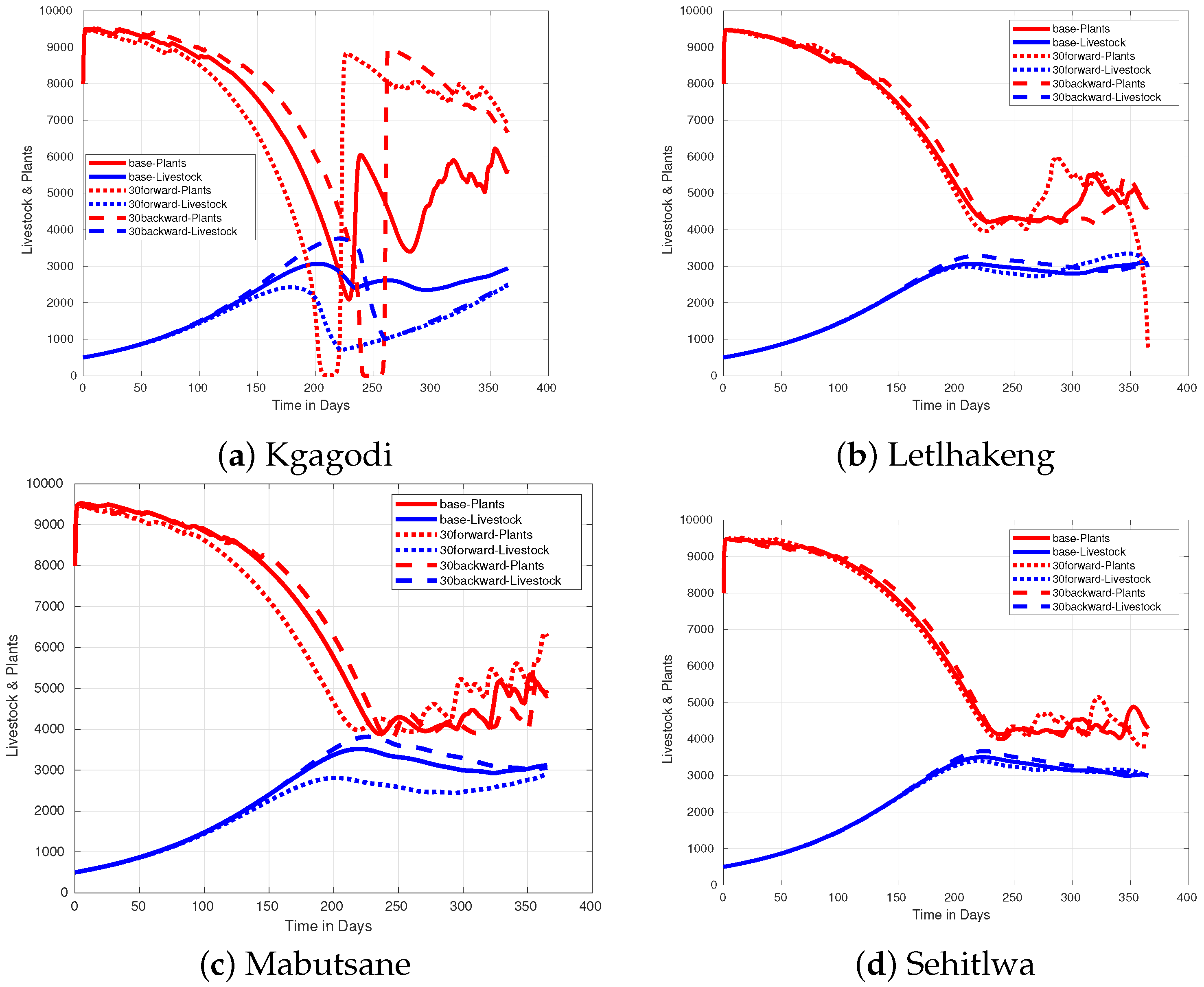
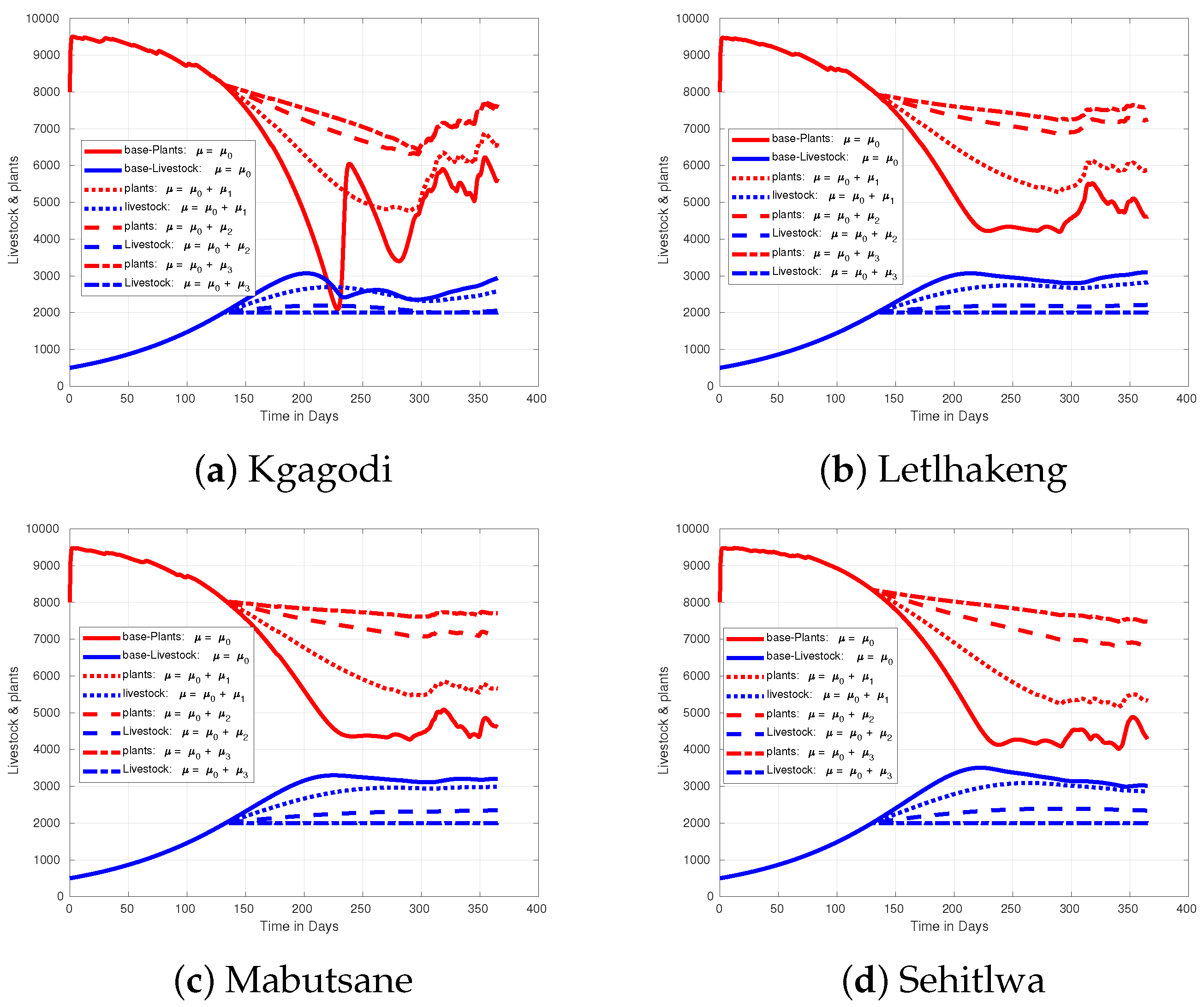
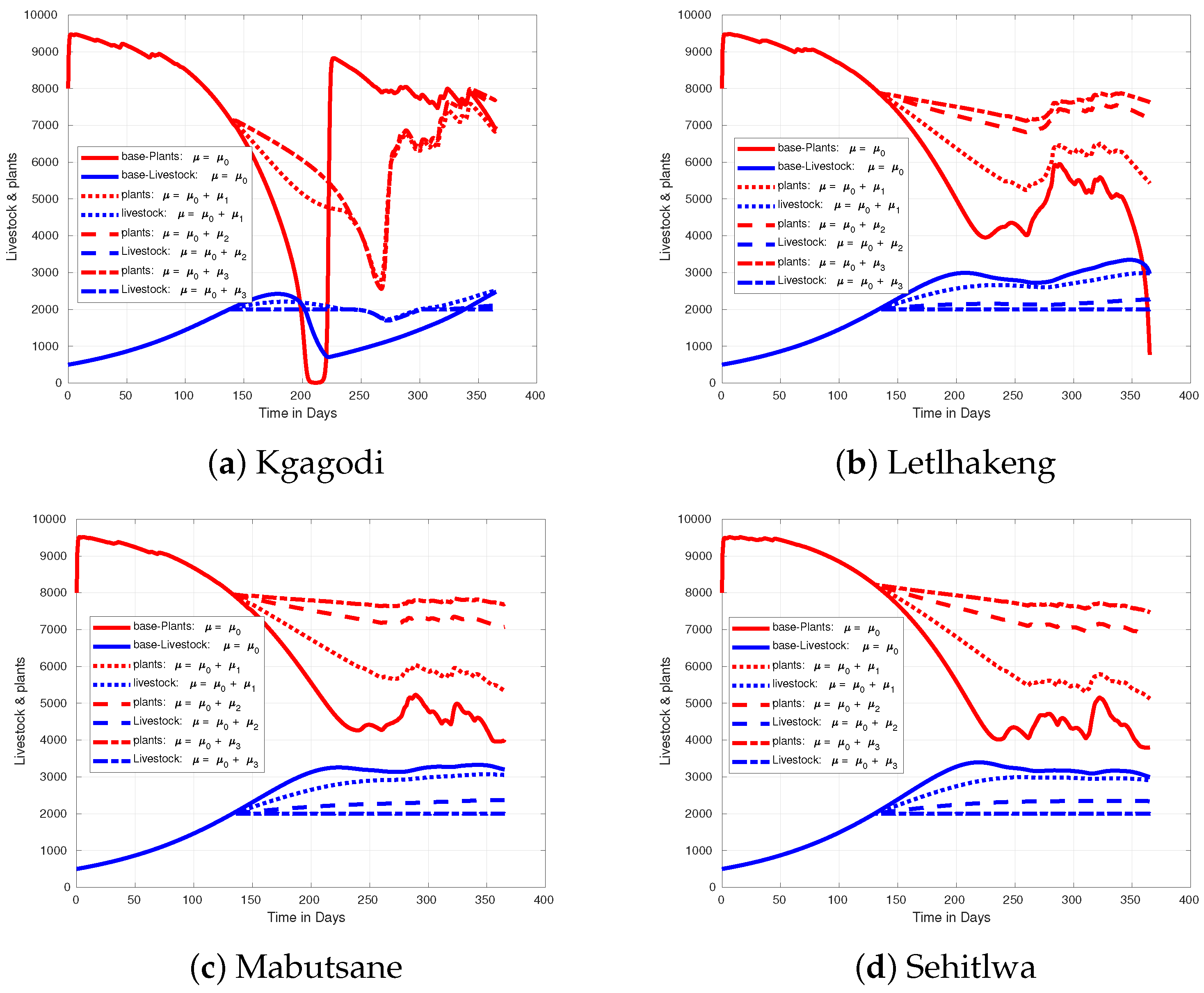
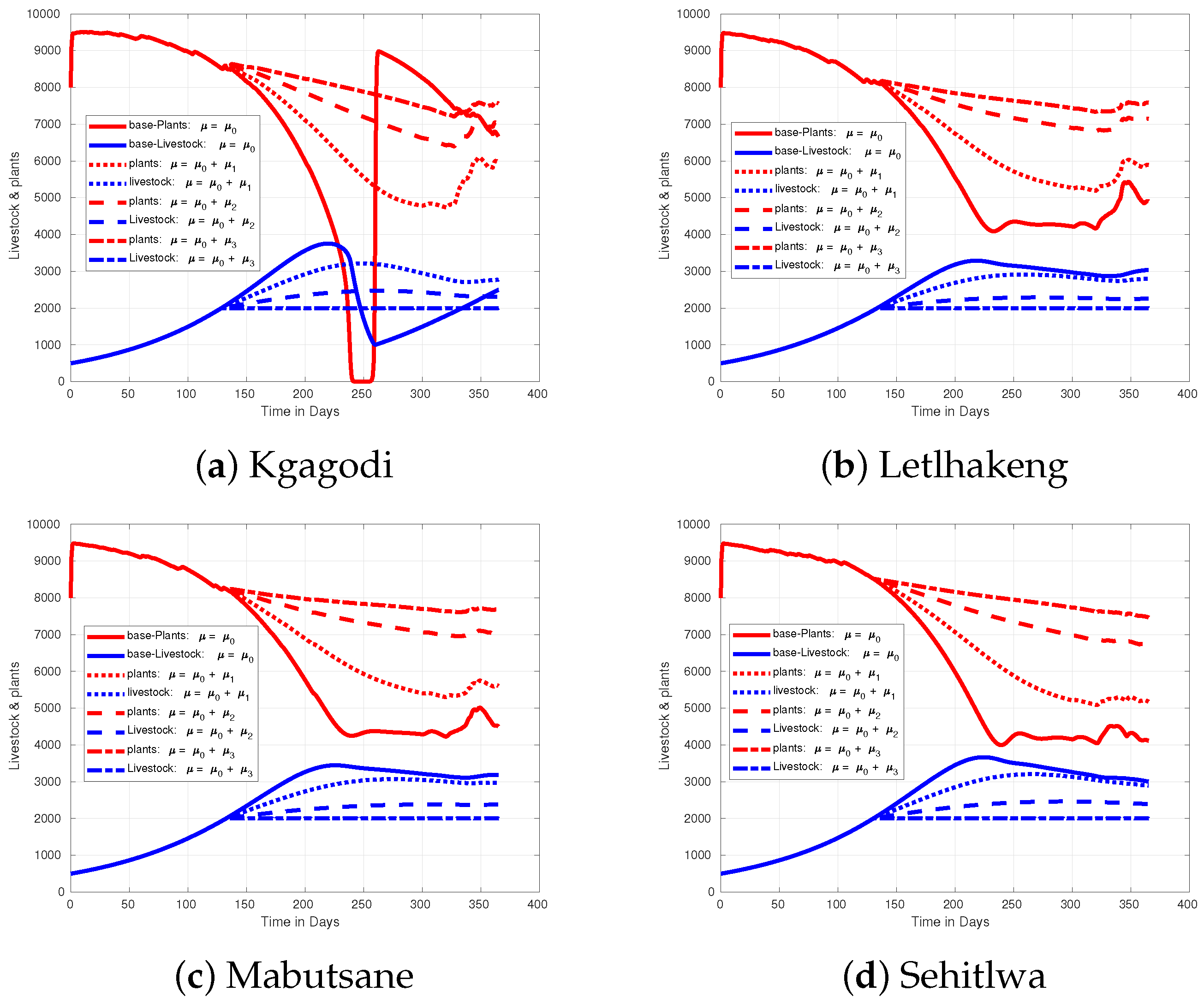
| Parameter | Units | Values | Description | Source |
|---|---|---|---|---|
| kg/km2 | 500 | Initial plant population | [13] | |
| kg/km2 | 8000 | Initial livestock population | [13] | |
| kg/day | 0.45 | Initial plant growth rate | assumed | |
| K | kg/km2 | 1000 | Carrying capacity | [13] |
| a | kg per km2 per day per head | of body weight | Feeding rate | [13] |
| b | kg/km2 | 160 | Half-saturated constant of feeding of livestock | [13] |
| d | per day | 0.005 | Constant death rate | Estimated |
| kg per km2 per day | Harvest rate | [13] | ||
| c | 2.5 | Efficiency of conversion | Estimated | |
| 0.1 | function amplitude | Estimated | ||
| per kg | Soil texture | Estimated | ||
| litre per day | variable | Rainfall standard deviation | Calculated | |
| litre per day | variable | Rainfall mean | Calculated |
Disclaimer/Publisher’s Note: The statements, opinions and data contained in all publications are solely those of the individual author(s) and contributor(s) and not of MDPI and/or the editor(s). MDPI and/or the editor(s) disclaim responsibility for any injury to people or property resulting from any ideas, methods, instructions or products referred to in the content. |
© 2025 by the authors. Licensee MDPI, Basel, Switzerland. This article is an open access article distributed under the terms and conditions of the Creative Commons Attribution (CC BY) license (https://creativecommons.org/licenses/by/4.0/).
Share and Cite
Nketsang, T.S.; Kassa, S.M.; Kgosimore, M.; Tsidu, G.M. Understanding the Impacts of Rainfall Variability on Natural Forage–Livestock Dynamics in Arid and Semi-Arid Environments. Appl. Sci. 2025, 15, 3918. https://doi.org/10.3390/app15073918
Nketsang TS, Kassa SM, Kgosimore M, Tsidu GM. Understanding the Impacts of Rainfall Variability on Natural Forage–Livestock Dynamics in Arid and Semi-Arid Environments. Applied Sciences. 2025; 15(7):3918. https://doi.org/10.3390/app15073918
Chicago/Turabian StyleNketsang, Thabo S., Semu Mitiku Kassa, Moatlhodi Kgosimore, and Gizaw Mengistu Tsidu. 2025. "Understanding the Impacts of Rainfall Variability on Natural Forage–Livestock Dynamics in Arid and Semi-Arid Environments" Applied Sciences 15, no. 7: 3918. https://doi.org/10.3390/app15073918
APA StyleNketsang, T. S., Kassa, S. M., Kgosimore, M., & Tsidu, G. M. (2025). Understanding the Impacts of Rainfall Variability on Natural Forage–Livestock Dynamics in Arid and Semi-Arid Environments. Applied Sciences, 15(7), 3918. https://doi.org/10.3390/app15073918







